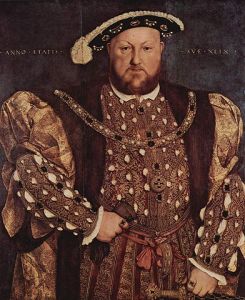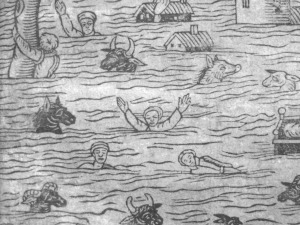
Henry VIII, in whose reign English-style, hereditary surnames began to be used in Wales among the upper classes
As a cataloguer of Welsh books – and, even more relevant perhaps, as a librarian looking after many shelves of books by Welsh authors in Cardiff University’s Salisbury Library – the difficulties presented by Welsh surnames is a subject dear to my heart. How often have I wished for fewer authors called Jones or Williams, who between them make our collection hard to shelve and use!
The modern trend away from Anglicised versions of Welsh surnames offers hope that one day names in Wales will not be dominated by the letters J, P and W (a long story, but this has more or less been the outcome of the end of the Welsh patronymic system). If you want to make your Anglicised Welsh name more Welsh, you have a number of options. You can simply use a Welsh form of the spelling (so Griffiths becomes Gruffydd, Jones becomes Iwan, and so on). Some use a Welsh version of their name in everyday life, but keep the Anglicised form for officialdom. Some have dropped the surname and replaced it with a middle name which then becomes the family name for future generations. Some have adopted a place name, such as the name of a farm. Bardic names, the names by which poets distinguished themselves, were often place names.
Here convention as to how to cite names begins to break down a bit, and from a cataloguer’s point of view has created an inconsistent muddle where sometimes people are referred to by their official, English, name with the bardic name in brackets, whereas others have suddenly metamorphosed into bardic name only. At Cardiff University we used to follow the pattern of the Dictionary of Welsh Biography (surname, first name, bardic name in brackets). There no longer seems to be any consensus about whose name still follows this order and whose doesn’t. There are many examples in Library of Congress authorities (the versions of names which are nearly always used in library catalogues) of both ways of doing it, including many where the bardic name is the main point of entry (such as Cynan, formerly Evans-Jones, Albert in our catalogue).
Names using “ap”, the traditional marker of the patronymic, are another problematic area. The medieval examples (Dafydd ap Gwilym, Gruffydd ap Rhys) are straightforward. These are genuine patronymics (Gruffydd ap Rhys was the son of Rhys, and so on). The main name is the first name. If there had been a phone book in the fourteenth century Dafydd ap Gwilym would have appeared under “D”. This is what still happens in Iceland to this day, where the first name is what counts, and a family of husband, wife, son and daughter will all have different names.
Modern Welsh “ap” seems to be more ambivalent. There are examples of people who have gone all the way and resurrected the patronymic system (Myrddin ap Dafydd is the son of Dafydd Parri), but others, while embracing what looks at first sight to be a name which would not be out of place in twelfth century Wales, stop short of taking the final step and throwing off the concept of the surname altogether. If married with children, the whole family has the same “ap” name. This is not a genuine patronymic system (it’s probably easier to live with from a bureaucratic point of view though!) The modern “ap” names cause all sorts of difficulties. Should the person’s first name still be the main one? Should it be the last element? or, should they all be called “Mr. Ap —-” and filed and shelved under A? Are Welsh “Ap” names, in other words, like Scottish and Irish Mc/Mac (another source of much distress to librarians)? Back to LOC authorities for guidance (incidentally, although we can’t expect the Library of Congress perhaps to be fully aware of all the nuances of Welsh naming, it’s worth pointing out that our own National Library of Wales is the source of many of the Welsh authority records). Again, there is not much consistency, although a preference seems to be emerging for the first element of the name to go first (Myrddin ap Dafydd, Hedd ap Emlyn) – but what is one to make of “Ap Glyn, Ifor, see Ifor ap Glyn” appearing just above “Ap Gwilym, Ifor, 1951-“? A trawl down the “ap” list only confirms that there is no standard (and makes you wonder where the term “authority” applies in all this).
Of course, as a librarian, I am biased. I want to get away from hunting through shelves of books by authors whose names all begin with the same letter! I don’t want to have to check and double-check which possible version of the name has been used before! Surely in a small country and with only a limited number of people affected it ought to be possible to achieve consistency. I must say that, apart from the thought of how UK bureaucracy might struggle with it, I’m all for the Icelandic system!
(This post first appeared in a slightly different form on http://helen-ceridwen.blogspot.co.uk/).




